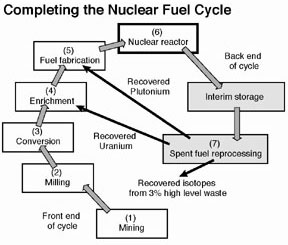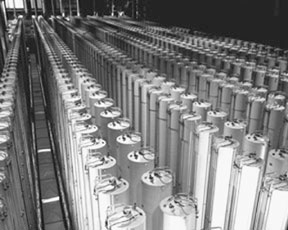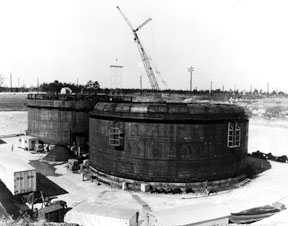
Home | Search | About | Fidelio | Economy | Strategy | Justice | Conferences | Links
LaRouche | Music | Join | Books | Concerts | Highlights | Education | Health
Spanish Pages | Poetry | Dialogue of Cultures | Maps
What's New
|
Physical Economy
|
The Beauty of Completing
the Nuclear Fuel Cycle
The U.S. pioneered the full nuclear fuel cycle, but gave it up in the 1970s, following a Ford Administration policy written under the direction of Dick Cheney.
Marjorie Mazel Hecht reports.1
|
||||||||||||||||||||
Nuclear power is a gift to humanity, and only the propaganda of Malthusian extremists, dedicated to stopping human progress and reducing the world’s population, has created public fear and skepticism.
The best way to overcome irrational fear is through knowledge. To this end, reviewed here is the process by which natural uranium ore is turned into fuel for a nuclear reactor, how it is used, and how it can be recycled, such that the reader will come to understand that there is really no such thing as nuclear “waste.”
The Nuclear Fuel Cycle
|
|||||||||||||||||||||
1. First, natural uranium is mined. There are enough sources of uranium worldwide for today’s immediate needs, but once we begin an ambitious nuclear development program (to build 6,000 nuclear reactors in order to provide enough electricity to bring the entire world population up to a decent living standard), we would have to accelerate the development of fast breeder nuclear reactors, which produce more fuel than they consume in operation.
2. Next, the uranium is processed and milled into uranium oxide (U3O8), called yellowcake, which is the raw material for fission fuel. Yellowcake became infamous in the political fabrication that Saddam Hussein’s Iraq was trying to import yellowcake from Niger, in order to use it for bomb-making.
It is basically natural uranium ore, which is crushed and processed by leaching (with acid or carbonate) to dissolve the uranium, which can then be extracted and concentrated to 75% uranium, in combination with ammonium or sodium-magnesium.
3. The concentrated uranium is then converted into uranium hexafluoride (UF6), which is heated into a gas form suitable for enrichment.
Uranium Enrichment
4. Natural uranium has one primary isotope, U-238, which is not fissionable, and a much smaller amount of U-235, which fissions. Because most uranium (99.276%) is U-238, the uranium fuel must go through a process of enrichment, to increase the ratio of fissionable U-235 to the non-fissionable U-238 from about 0.7% to 3 to 4%. (Weapons uranium is enriched to about 93% U-235.)
The technology of enrichment was developed during the World War II Manhattan Project, when the object was to create highly enriched uranium (HEU) to be used in the atomic bomb. Civilian power reactors use mostly low-enriched uranium (LEU). (Canada has developed a type of reactor, the CANDU, which uses unenriched, natural uranium in combination with a heavy water moderator to produce fission.)
|
|||||||||||||||||||||
The Manhattan Project devised this method of gaseous diffusion with incredible speed and secrecy. It was not finished in time to produce all the uranium for the uranium bomb dropped on Japan, but it produced most of the enriched uranium for the civilian and military programs in subsequent years. Although a successful method, it required a tremendous amount of energy and a huge physical structure to house the “cascades” of separate membranes. Four power plants were built in Oak Ridge, Tenn., to power the process, producing as much electric power as the consumption of the entire Soviet Union in 1939! Almost all the power consumed in the diffusion process is used to circulate and compress the uranium gas.
Technological pessimists take note: At the time the gaseous diffusion plant was being built, scientists had not yet figured out how to make a membrane to be used in the process—but they did it in time to make it work!
The centrifuge system, used in Europe and Japan, is 10 times as energy efficient. The strong centrifugal field of a rotating cylinder sends the heavier isotope in uranium hexafluoride to the outside of the cylinder, where it can be drawn off, while the U-235 diffuses to the inside of the cylinder. Because of the limitations of size of the centrifuge, many thousands of identical centrifuges, connected in a series called a cascade, are necessary to produce the required amounts of enriched uranium.
A centrifuge plant requires only about 4% of the power needed for a gaseous diffusion plant, and less water is needed for cooling.
Other methods of enrichment are possible—electromagnetic separation, laser isotope separation, and biological methods.
Fabrication Into Fuel Rods
 |
|||||||
 |
|||||||
| U.S. AEC A cylinder of uranium hexaflouride enriched in U-235 is readied for shipment to a conversion facility, where it will be converted to uranium dioxide for use in fuel rods. The cylinder weighs 2.5 tons. |
|||||||
| Westinghouse Photo A partially completed nuclear fuel assembly. The long tubes guide the control rods in the reactor, which regulated its operation. The grids that hold the guide sheaths also align the fuel rods containing uranium pettets. When the fuel rods are inserted through the grids, parallel to the guide sheath, the fuel assembly will be completed. |
|||||||
5. Once the enriched uranium is separated from the depleted uranium, it is converted from UF6 into uranium dioxide and fabricated into uniform pellets. The pellets are loaded into long tubes made out of a zirconium alloy, which captures very few neutrons. This cladding prevents the release of fission products and also transfers the heat produced by the nuclear fission process in the fuel. The fuel is then transported to the reactor site.
Different types of reactors require different designs of fuel rods and fuel bundles. In a light water reactor, the fuel rods are inserted into the reactor to produce fission, which creates steam, which turns a turbine that creates electricity.
The fuel for the next-generation high-temperature gas-cooled reactors is different: The enriched uranium is formed into tiny “pebbles” which are coated with graphite and special ceramics that serve as individual “containment buildings” for the fuel pebbles.
6. Fuel rods are used for about four and a half years before replacement, and usually a reactor replaces about a third of its fuel at one time. The fuel is considered spent when the concentration of fissile uranium-235 becomes less than 1%. When removed from the reactor, the spent fuel is put into cooling pools, which shield it as its short-lived nuclides decay. Within a year, the total radioactivity level is only about 12% of what it was when the fuel rod came out of the reactor.
At present, the United States does not reprocess spent fuel, and so the spent fuel rods sit in cooling pools at the reactor. After the spent fuel has cooled, it is stored in dry casks, waiting—for “burial” or reprocessing.
But the spent fuel is not “waste”! It contains between 90 and 95% of usable uranium, that can be separated out and recycled into new fuel, and it also contains a smaller amount—about 1%—of plutonium, a fuel for breeder reactors.
Reprocessing
|
|||||||||||||||||||||
The reprocessing method that was successfully used in the United States at the Savannah River facility in South Carolina for military purposes, is just as efficient for civilian spent fuel. Spent fuel rods are processed to remove the highly radioactive fission products, and separate out (partition) the fissionable U-235 and plutonium.
This plutonium could be directly used as fuel for breeder reactors, which was the intention of the completed fuel cycle. It can also be used to make mixed-oxide fuel, or MOX, which some of today’s reactors are being converted to burn as fuel. (Thirty-five reactors in Europe now use MOX fuel.)
The reprocessing facilities at Savannah River were called “canyons” because they were tall, narrow buildings. The spent nuclear fuel was handled remotely by technicians who were behind protective walls. This was large-scale industrial processing, which was entirely successful, safe, and safeguarded.
Once the uranium was separated out, it was sent to another building at Savannah River to be fabricated for weapons use. The remaining amount of highly radioactive fission products—a tiny fraction of the spent fuel—was set aside for vitrification and storage. Today, the technologies exist, or could be developed, to extract valuable medical and other isotopes from this 3% of high-level waste. Virtually all of the spent fuel could be made usable.
U.S. civilian spent fuel could be reprocessed in a similar fashion using the Savannah River model—or by new technologies still to be developed.3 Right now, Britain, France, Russia, and India reprocess civilian spent fuel, using the Purex method (which stands for Plutonium Uranium Extraction), and Japan has a commercial reprocessing plant now in a testing start-up phase. Other nuclear nations send their spent fuel to Britain or France for reprocessing, or they store it. China reprocesses military spent fuel.
Who Opposes Reprocessing?
|
|||||||||||||||||||||
The overt arguments against reprocessing are mostly scare tactics: Permitting U.S. reprocessing will make it easier, they say, for “bad guys” to build bombs—or dirty bombs. This is the gist of the objection, although it may be posed at length in more academic (and tedious) language.
But this argument is one based on fear—fear that an advanced technology can never be managed properly, and fear that we will never have a world where there aren’t “bad guys” who want to bomb us. It is the opposite of the Atoms for Peace philosophy.
In fact, if one is truly worried about diversion of plutonium, why not burn it to produce electricity, instead of letting it accumulate in storage? And as Savannah River manager William P. Bebbington, a veteran of the Manhattan Project, wrote in a landmark 1976 article on reprocessing, “Perhaps our best hope is that someday plutonium will be more valuable for power-reactor fuel than for weapons, and that the nations will then beat their bombs into fuel rods.”4
A second objection is that reprocessing is not “economical”; it is cheaper to have a “once through cycle” and discard the spent fuel. But the cost/benefit basis on which such economics are calculated is a sham. What is the cost of not reprocessing—in terms of lives lost and society not advancing? And what about the cost of the storage of spent fuel—not to mention the still unused U.S. storage facility at Yucca Mountain, Nevada, which has become a costly political and emotional football.
The “proliferation” argument was key in 1976 in stopping U.S. reprocessing. Fear was fed by the idea that reprocessing would make more plutonium available, which could be diverted by “rogue” nations or groups to make clandestine nuclear weapons. President Ford, the incumbent, carried out a secret study, and issued a nuclear policy statement on Oct. 28, 1976, just five days before the election, which advocated an end to reprocessing.
Jimmy Carter, who won that election, then carried out the policy to stop U.S. reprocessing; and the next President, Ronald Reagan, sealed the lid on the fuel-cycle coffin with the idea of “privatizing” both reprocessing and breeder reactors.
The full story of how reprocessing was stopped still has to be told. But the ending of the story is clear: The United States shot itself in the foot—twice: 1) The United States stopped an important technology, which this country had pioneered, and 2) the U.S. anti-reprocessing policy did absolutely nothing in the rest of the world to stop other countries from developing the full nuclear fuel cycle, or desiring to.5
Interestingly, the Ford Administration’s policy in 1976, which advocated killing U.S. reprocessing for the same fallacious reasons that President Carter later elaborated, was written under the direction of Ford’s chief of staff—Dick Cheney. And one of the key reports supporting Carter’s ban on reprocessing was written by the mentor of the leading neo-cons in the Bush Administration, Albert Wohlstetter, then a consultant to the Department of Defense.
Once the political decision is taken to begin an ambitious nuclear construction program, reprocessing—both Purex and new technologies—will follow.
For Further Reading
Scott W. Heaberlin, A Case for Nuclear-Generated Electricity ... or why I think nuclear power is cool and why it is important that you think so too (Columbus, Oh.: Battelle Press, 2004).
Alan Waltar, Radiation and Modern Life (Amherst, N.Y.: Prometheus Books, 2004).
See also: http://www.world-nuclear.org/education/education.htm on the fuel cycle.
1. Reprinted from 21st Century Science & Technology, Winter 2005-06. See www.21stcenturysciencetech.com.
2. The energy density of nuclear can be seen by comparing fission fuel to other sources. In terms of volume of fuel necessary to do the same amount of work, a tiny pellet (1.86 grams) of uranium fuel equals 1,260 gallons of oil, or 6.15 tons of coal, or 23.5 tons of dry wood. This means that nuclear is 2.2 million times more energy dense than oil, and 3 million times more energy dense than coal. Thermonuclear fusion will be even orders of magnitude more energy dense. These calculations were based on the work of Dr. Robert J. Moon in 1985.
3. The U.S. Congress in the 2005 Energy Act included $50 million for research on new reprocessing methods.
4. “The Reprocessing of Nuclear Fuels” by William P. Bebbington, Scientific American, December 1976, pp. 30-41.
5. Commenting on President Carter’s 1977 policy to shut down reprocessing and the Clinch River Breeder Reactor, Bernard Goldschmidt, a preeminent French nuclear scientist, who had studied with Marie Curie, wrote: “By this extraordinary and unique act of self-mutiliation, an already declining American industry was to become paralyzed in two key sectors of future development, fuel reprocessing and breeder reactors, precisely the sectors in which the United States was already between 5 and 10 years behind the Soviet Union and Western Europe, in particular, France....”
What is the Schiller Institute?
How to Rebuild the World Economy
LaRouche’s New Bretton Woods Monetary System
Maps of Great Infrastructure Development Projects Around the World
Several Recent Lyndon LaRouche Economic Articles:
The Auto Crisis: What LaRouche Said, And What Happened
Nuclear Power Is Crucial for Reconstruction
How to Capitalize A Recovery (PDF file)
Writings of Other Great Thinkers
Biography of Friedrich Schiller
![]()
schiller@schillerinstitute.org
The Schiller Institute
PO BOX 20244
Washington, DC 20041-0244
703-297-8368
Thank you for supporting the Schiller Institute. Your membership and contributions enable us to publish FIDELIO Magazine, and to sponsor concerts, conferences, and other activities which represent critical interventions into the policy making and cultural life of the nation and the world.
Contributions and memberships are not tax-deductible.
VISIT THESE OTHER PAGES:
Home | Search | About | Fidelio | Economy | Strategy | Justice | Conferences | Links
LaRouche | Music | Join | Books | Concerts | Highlights | Education | Health
Spanish Pages | Poetry | Dialogue of Cultures | Maps
What's New
© Copyright Schiller Institute, Inc. 2006. All Rights Reserved.




